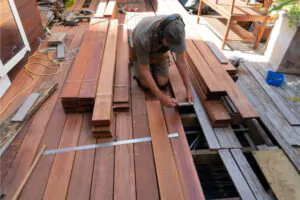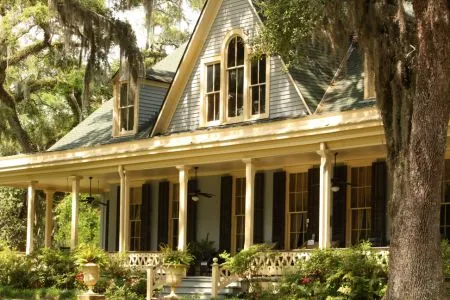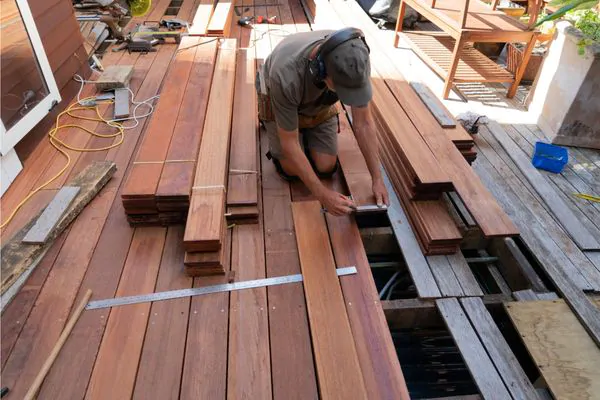Selecting the correct type of wood for your deck enhances its beauty and extends its durability and longevity. With many options available, each type of wood offers unique qualities, from rich aesthetics to enduring resistance against the elements. Understanding the nuances among the different types of wood for a modern deck building can influence your outdoor space’s functionality and overall look. Keep reading to uncover the best wood for your deck, navigating through many choices to find the perfect match for your outdoor oasis.
I. Types of Wood for Decks
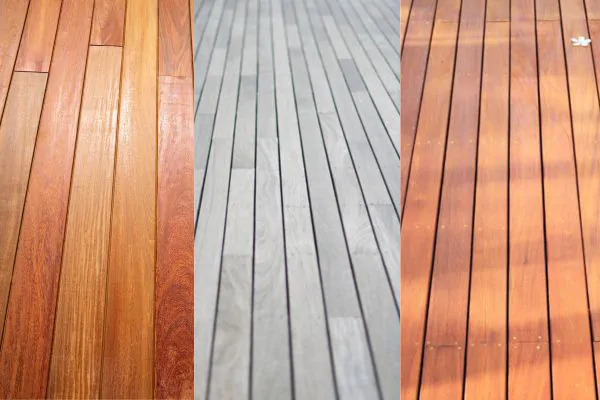
Choosing the best from the various types of wood for deck construction is pivotal to your project’s success, offering both aesthetic appeal and long-term durability. Options range from the classic charm of hardwoods and softwoods – each with distinct characteristics – to innovative solutions like composite wood, which blends materials for enhanced performance.
Notable among hardwoods is ipe, celebrated for its incredible strength and resistance to the elements, setting a high standard for outdoor decking materials. Cedar and redwood, on the other hand, stand out in the softwood category, offering natural beauty along with an inherent resistance to decay and pests, making them prime choices for those seeking a balance between looks and longevity. Pressure-treated wood presents a cost-effective yet robust solution, undergoing unique
treatments to withstand moisture and fend off termites. Meanwhile, tropical hardwoods emerge as exotic alternatives, parading unmatched density and durability that cope well with outdoor conditions. Lastly, composite wood redefines decking materials by merging plastic with wood fibres to create decks that offer the best of both worlds: the natural appearance of wood without the high maintenance it typically demands. Each of these options embodies unique qualities and challenges. We’re here to navigate homeowners through the intricate process of selecting the best wood for their deck, tailored to their specific aesthetic and functional requirements.
1. Hardwood vs. Softwood
The initial choice between hardwood and softwood sets the groundwork for any deck project, influencing not only the aesthetic outcome but also the durability and required maintenance of the deck. Hardwoods, deriving from slow-growing trees, boast a denser composition, offering decks unparalleled strength and resistance to wear. In contrast, softwoods come from faster-growing trees, providing a more cost-effective yet equally beautiful decking alternative with a lighter, more flexible structure conducive to specific design aesthetics and climates.
2. Ipe
Ipe, often hailed as the premier choice among hardwoods for deck building, stands out for its remarkable density and ability to withstand the rigors of outdoor environments. Its rich, natural color and grain patterns elevate the aesthetic of any outdoor space, while its resistance to rot, decay, and insect infestation ensures a deck that lasts for decades with minimal maintenance. Embracing ipe for a deck project translates into investing in unparalleled durability and timeless beauty.
3. Cedar
Cedar emerges as a sought-after choice for decking due to its natural appeal and intrinsic qualities that promote longevity and resistance to the elements. Its aromatic scent adds a unique sensory dimension to outdoor spaces. At the same time, the wood’s inherent oils deter pests and decay, ensuring a durable deck with a distinct, rustic charm. Opting for cedar means selecting a wood that harmoniously blends aesthetics with practicality, a feature highly valued by deck builders aiming for beauty and functionality.
4. Redwood
Redwood, cherished for its vibrant hue and remarkable resistance to shrinking and warping, makes an excellent option for deck building. Its natural compounds fend off decay and pests, making it an ideal material for those prioritizing longevity alongside aesthetic value. Choosing redwood for a deck means committing to a material that ages gracefully, maintaining its beauty and structural integrity over time.
5. Pressure-treated wood
Pressure-treated wood, treated with chemicals to resist rot, moisture, and insect damage, offers an economical and durable option for deck building. Its treatment process ensures a longer lifespan, making it a practical choice for those seeking a reliable but cost-effective wood for their patio deck. This type of wood stands up to the elements, providing a sturdy and resilient foundation for outdoor living spaces.
6. Tropical hardwoods
Tropical hardwoods, like teak and mahogany, introduce an element of luxury and exotic appeal to deck construction, featuring exceptional durability and a natural resistance to decay and insects. The dense structure of these woods not only withstands the harsh outdoor environment but also evolves gracefully, developing a sought-after silver patina that adds an extra layer of character to the deck over time. Opting for tropical hardwoods means choosing a material that combines visual appeal with longevity, perfect for those aspiring to create an outdoor space that stands out.
7. Composite wood
Composite wood, a novel contender in the decking industry, strides forward by blending natural wood’s tactile warmth with synthetic materials’ resilience. This innovative decking option stands the test of time with minimal upkeep while resisting stains, fading, and moisture damage more effectively than traditional lumber. Opting for composite wood means embracing a sustainable, low-maintenance choice that captures the essence of wood for patio decks without the usual wear and tear.
II. Qualities to Look for in Deck Wood
Selecting the best types of wood for a deck construction project involves more than just aesthetic preferences; it requires a deep understanding of the material’s inherent properties.
The longevity of a deck largely depends on the durability of the wood, its ability to resist rot, insects, and wear, as well as the level of maintenance it demands. These critical factors guide homeowners and builders alike, ensuring that the final choice matches the user’s lifestyle and the climate in which the deck will exist.
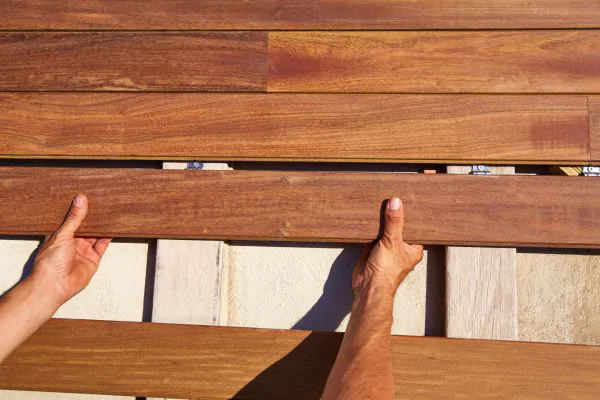
These characteristics stand at the forefront of selecting the optimal wood for a patio deck, balancing natural beauty with functional resilience.
1. Durability
Durability stands as a cornerstone quality in selecting the optimal wood for deck construction, ensuring the project stands the test of time and withstands the rigors of outdoor exposure. Woods like ipe and composite materials excel in enduring harsh weather conditions, resisting decay, and maintaining their integrity over years of use. This resilience directly translates into fewer deck repairs and replacements, safeguarding the investment in your outdoor living space.
2. Resistance to rot, insects, and decay
When selecting wood for deck construction, one indispensable quality is its natural or treated resistance to rot, insects, and decay. Woods like cedar and redwood shine in this regard, thanks to their inherent oils that repel pests and prevent deterioration.
In contrast, pressure-treated lumber undergoes a chemical process to imbue it with similar protective properties. This characteristic is critical as it determines the deck’s longevity, ensuring that the structure remains safe and aesthetically pleasing for years, even in the face of the relentless outdoor environment.
3. Maintenance
Maintenance must be considered when deciding on the best wood for deck projects. A material requiring less upkeep translates to more time enjoying the outdoor space and less time laboring over it. While composite lumber offers the advantage of minimal maintenance, maintaining its appearance and durability without the need for frequent staining or sealing, natural woods like cedar and redwood also present a low-maintenance option.
Their natural oils protect against the elements, albeit with slightly more care required to preserve their natural beauty over time.
III. Comparison of Different Wood Types for Decks
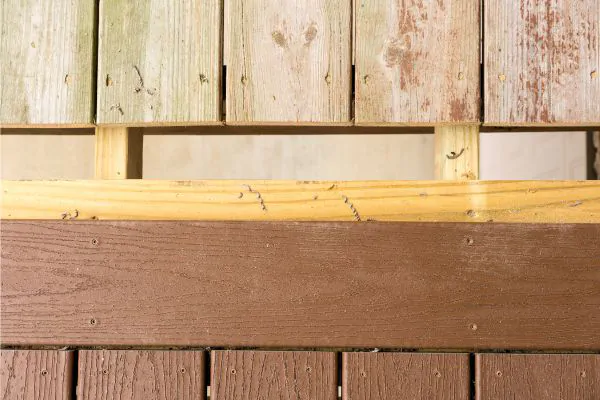
Embarking on a deck project brings to light significant considerations such as cost, appearance, and lifespan that profoundly influence the decision-making process regarding the type of wood to employ.
Each variety of wood, from the robust ipe to the innovative composite, presents a unique profile in terms of financial investment, aesthetic impact, and durability.
Delineating these factors allows for a nuanced understanding of how deck wood types align with project goals and personal preferences, guiding homeowners toward a choice that harmonizes with their outdoor living aspirations and practical requirements.
1. Cost
The financial aspect of selecting wood for a deck must be balanced, with costs varying significantly across different types. Pressure-treated wood is often the most budget-friendly option. In contrast, premium choices like ipe and certain tropical hardwoods command higher prices due to their unmatched durability and aesthetic qualities.
On the other hand, composite wood, while initially more expensive than some natural woods, offers savings over time with its low maintenance requirements, presenting an economically sound choice for long-term decking projects.
2. Appearance
The aesthetic appeal of a deck is significantly influenced by choice of wood, with each type offering distinct visual characteristics that can enhance the outdoor space’s overall ambiance. Woods like cedar and redwood impress with their natural beauty, showcasing wealthy colors and grain patterns that evolve gracefully over time.
Meanwhile, composite wood mimics the appearance of natural wood with a range of colour options and textures, providing a versatile alternative for those seeking both beauty and durability without the extensive maintenance traditional wood might demand.
3. Lifespan
The lifespan of a deck significantly hinges on the type of wood chosen, with some materials promising decades of reliability. In contrast, others may require more frequent replacement or repair. Hardwoods like Ipe and carefully selected tropical hardwoods offer longevity beyond compare, capable of gracing an outdoor space with their presence for over 40 years when properly maintained.
Conversely, options such as pressure-treated lumber, while initially robust, often present a shorter operational life, necessitating eventual renewal or comprehensive upkeep to prolong their utility.
Conclusion
Selecting the right one from the different types of wood for a deck is crucial for ensuring its aesthetic appeal, durability, and long-term performance.
From the dense and sturdy ipe to the natural beauty and resistance of cedar and redwood, each type of wood offers unique benefits to meet different aesthetic and functional requirements.
Pressure-treated wood provides a cost-effective, durable option, while tropical hardwoods add exotic luxury and durability to any deck.
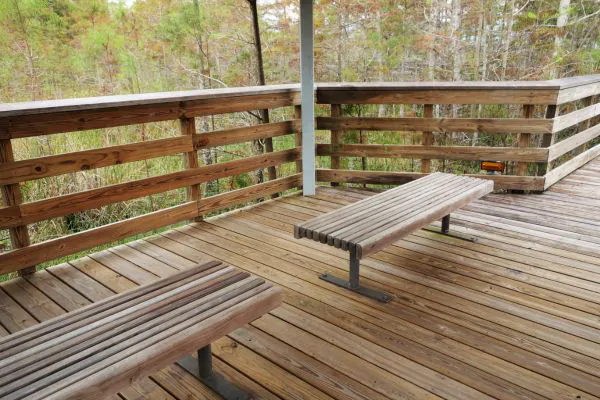
Composite wood represents a blend of beauty and low maintenance, making it an attractive choice for those seeking longevity without constant upkeep.
The decision between these options should consider factors such as cost, appearance, maintenance needs, and lifespan, ultimately guiding homeowners to a choice that aligns with their outdoor living aspirations and practical necessities.



